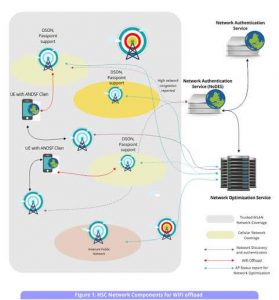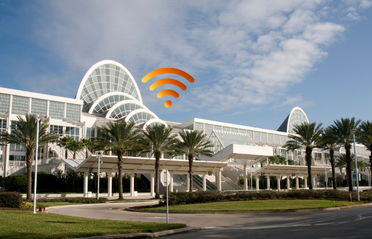Wi-Fi as a technology is nearing two decades and the Wi-Fi alliance itself is 15 years old. With the ubiquity of smartphones, Wi-Fi has made impressive strides as the transmission technology of choice for Internet data; it is reported that fully 40% of Internet mobile traffic is carried on Wi-Fi (The Economist 2014). Wi-Fi is also making impressive inroads into voice calling.
However, the one weak spot in Wi-Fi remains the interworking with cellular technologies; so called Wi-Fi offload. While the technology has been available for quite some time, the actual realization has been rather slow. In 2013, it was reported that Wi-Fi public networks carried less than 10% of smartphone originated traffic (Parker 2013). This, despite efforts of the cellular world and Wi-Fi to promote collaboration; as early as 2007, 3gPP released TR 23.234 as the first attempt to standardize cellular and Wi-Fi interworking. Yet, as late as 2015, Wi-Fi offload remains in the experimental stage (Ablott 2013). And while Cisco projects 50% offloading of cellular traffic in 2016 (Networks 2015), a large majority of this is actually initiated by the user in her home.
The case for automatic Cellular-Wi-Fi-offload is strong, both technically and commercially. In theory, by offloading low-revenue high-volume internet traffic from the expensive cellular network to the cheaper, unlicensed,low-range Wi-Fi network, it will be possible to provide higher service to premium users and keep up with the explosive growth of Internet data access. While WLAN and 3gPP are clearly competing in other areas; for example, voice and IoT, this is an area where the two organizations, at least apparently, are willing to cooperate. A recent paper by the Small Cell Forum and the Wireless Broadband Alliance (Small Cell Forum, Wireless Broadband Alliance 2016) represents an effort by two industry bodies to standardize on a common architecture.
Problems of WiFi Offload:
In conversations with customers and our own experiments, we have identified the following four issues with Wi-Fi offload. All of them have potential redressal, but that needs cooperation between the network equipment vendors, network operators and client software. The bulk of Internet access today takes place through Smartphones, hence we are specifically talking about changes to be incorporated by Apple (iOS), Google (Android), Microsoft (Windows Phone), etc.
Finding good service
Outside of the home area, a user would like her smart phone to automatically discover the hot-spots available, vet them for security and move to them automatically, if they are able to provide better or the same level of service as the cellular network. Unfortunately, this is not implemented in any public Wi-Fi network. At best the users can find a list of the Hotspots provided by their service provider; they do not get any information about the level of service available. Whereas cellular networks provide some implicit guarantee of service levels i.e. most handovers work without call-drops, there is nothing similar in public Wi-Fi access.
3gPP has attempted to address this problem using an Access Network Discovery and Selection Function (ANDSF) component that can be added to the cellular network providersí services. By using a standard XML based query mechanism, an appropriate ANDSF client on the UE can upload its own current location and requirements to a ANDSF server in the network and get back a prioritized list of Wireless LANs (as identified by SSIDs) to which it can attempt to connect to for the purpose of off-loading [3gPP TR 23.402 and 24.302].
If the WLAN supports Hotspot 2.0, the UE can then use the ANQP procedures to identify the exact network nodes available, loading and other information. A bigger problem is to have the infrastructure which can determine the optimal Access Point for the offloading UE, given its location, network conditions, etc.
Security of Access
By far the largest problem is security of access. Users who are not familiar with the concept of two-way authentication are very reluctant to trust 3rd party hotspots; this is probably the biggest reason why users prefer to off-load to their own home Wi-Fi rather than allowing automatic off-load to public Wi-Fi hotspots. Too many WLAN networks do not have two party authentication switched on; WLAN clients donít want the user when they are connecting to a hotspot which is unauthenticated; even enterprises operate on the basis of SSIDs with passwords, without switching on more advanced features such as 802.1x dual authentication (WPA2 enterprise mode).
Cellular security, which has a good reputation, is based mostly on SIM based authentication; however, integrating this with WLAN has its challenges. While the network side infrastructure is standardized, the access to the SIM is intentionally obscured on the client device. Nonetheless, EAP-SIM, if widely deployed in public hotspots with automatic offload will increase the seamless nature of the access and (given that users already trust their cellular providers) will allay fears of rogue networks and Access Points.
Hotspot 2.0 supports X.509 certificated based authentication along with SIM based authentication, with single-sign-on provisions. This is possible to implement using standalone infrastructure; X.509 certificates can be generated on the fly and installed in the userís equipment, with periodic or one-time authentication of user-identity through RADIUS; this is possible both in carrier WLAN (using HSS authentication via DIAMETER) or enterprise WLAN (using the enterprise AAA service). While X.509 based security is weaker than SIM based security, it is not dissimilar to the level of service available using HTTPS connections over the Internet. This simplifies the client software and reduces load on the network infrastructure significantly.
Seamless Offload
Given that the UE is capable of identifying a capable, secure AP to offload to, this still requires a seamless transfer of the existing data-sessions. While this is possible using various methods, these require some capital infrastructure on the network side and is often insufficiently available.
An even more desirable function would be the handover of individual flows; for example, if the user is talking, Internet browsing and downloading streaming content simultaneously, only the browsing sessions (or streaming content) is offloaded, as per the capabilities of the new WLAN. This feature is called IFOM and requires significant changes in the UE; specifically, a dual-mode IP stack. While dual-mode stacks are available in mainstream Operating Systems such as Linux, they are not available today in existing mobile platforms.
HSC Infrastructure for WiFi Offload
HSC has invested in a developing a complete suite of infrastructure targeted at the various different aspects of Wi-Fi offload discussed here. A view of the different components
Network Optimization and Discovery Service
The Network Optimization Service (NoDES) tracks information about the individual Access Points which are part of the network; the agents on the access points push their current status to the NoS server using a pre-defined REST based API. The NoDES also offers interfaces to Aps and 3G UEs which allow them to authenticate themselves. Based on the declared location of the UE and other parameters, the Network Optimization Service can use the data-base of Access Points to identify the optimal set of Access Points for the UE to use in a prioritized list.
The network optimization service also uses the current loading information to set individual Access Point targets in terms of coverage, load and traffic levels. This is used by the SON agent on the access point to configure and manage the Access Point, described in next section. The solution is implemented on a Linux platform and is Cloud deployable.
Distributed Network Optimization Agent
The Distributed Network Optimization agent is a software which sits inside the Access point and communicates with the Network optimization backend (as shown in Figure ). The D-SON agent has the following two functions:
- It implements dynamic power management, interference sensing and automatic channel selection based on the parameters given to it from the NOS.
- It measures system congestion and load and reports this to the Network Optimization.
The D-SON agent is based on a distributed optimization algorithm developed by HSC (Saha 2009).
ANDSF Client
HSC has developed an ANDSF client for Android phones which can be used to implement Wi-Fi offload solutions. It implements the basic ANDSF interaction with the ANDSF interface of the NoS and then applies the results on the Android phone.
Network Authentication Service
The HSC Network Authentication service comprises of the following three specific functions:
- A service for user authentication (using RADIUS/DIAMETER) and consequent generation, verification of and repudiation of X.509 certificates.
- An online signup solution, as dictated by Passpoint standards, which allows a new user to authenticate herself to the network. The OSU acts as an authentication proxy and can connect to any standard authentication system using Radius/Diameter to verify the credentials of a particular user.
- A service for interaction with the Access Points as required by Passpoint to implement generic advertising, query handling and user-access using SOAP
Integrated view of the Network Service
Figure 1 gives an integrated view of the HSC Offload network service as described here. On the right side we show the HSC network services. In the green rectangle (cellular coverage), we note two UEs which have migrated their connections off cellular to Wi-Fi offload. The one in the top has chosen a less congested WLAN Access Point (the congested access point is shown in dark mustard), whereas the one in the bottom has chosen a secure access point (the insecure network is shown in red).
Roadmap
It is widely believed that next generation networks will see the widespread incorporation of small-cells, as well as the possibilities of enabling true HetNet operation. This involves stitching together small-cells, Wi-Fi Access Points and the macro-cellular network into a single homogenous service entity. With the introduction of larger numbers of small cells (due both to traffic engineering, as well as the migration to higher frequencies such as mm-wave), the network architecture will change significantly. It is anticipated that the appropriate mix of small-cells, WLAN and macro-cell network will bring significant savings in power usage, backhaul and other infrastructure costs, as well as spectrum loading. (Small Cell Forum, Wireless Broadband Alliance 2016).
In this scenario, the WLAN authentication and discovery shall become a core part of the 5G network architecture. Corresponding network services infrastructure has to be designed to fit into the different network deployment architectures in this mixed network model.
Bibliography
Ablott, Matt. GSMA Intelligence. 21 March 2013.
Networks, Cisco. Cisco Visual Networking Index. 3 February 2015.
Parker, Tammy. FierceWirelessTech. 21 February 2013.
Saha, Abheek. ìA Distributed Power Management Algorithm for a Self-optimizing Wi-Fi Network.î 9th Advanced International Conference on Telecommunications. AICT, 2009. 23-28.
Small Cell Forum, Wireless Broadband Alliance. Industry perspectives, trusted WLAN architectures and deployment considerations for integrated Small-Cell Wi-Fi (ISW) networks. Industry Report, SCF,WBA, 2016.
The Economist. November 2014.

Product Engineering Services Customized software development services for diverse domains
Quality Assurance End-to-end quality assurance and testing services
Managed Services Achieve scalability, operational efficiency and business continuity
Technology Consulting & Architecture Leverage the extensive knowledge of our Domain Experts




